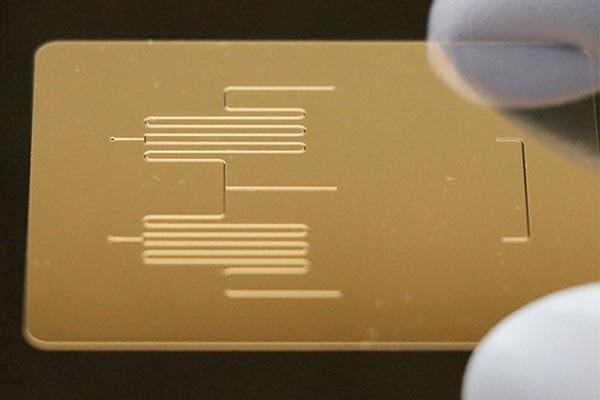Microfluidics is a relatively new technology having been in use since the 1990s. In this article, we’ll cover the definition of microfluidics, common uses of microfluidics, and types of microfluidics. Let’s get started.
What is Microfluidics?
Microfluidics is defined as both the science which studies the behavior of fluids through micro-channels, and the technology of manufacturing microminiaturized devices containing chambers and channels which fluids flow or are confined. As the name implies, microfluidics deal with very small volumes of fluids.
At Citrogene, we specialize our focus on creating the technology needed to administer, or monitor, the flow of fluids at a micro-scale. Click here to learn more about how we will partner with you to create a unique glass microfabrication product suited to your specific needs.

A Microfluidic Flow Cell.
Microfluidic Chips
A microfluidic chip is a pattern of microchannels and microchambers, that have either been molded, machined or engraved into different materials. These microchannels and microchambers are incorporated into the microfluidic chip and linked to the macro-environment. It is via these links that fluids are injected into and evacuated from the microfluidic chip. Fluids can be directed, mixed, and separated depending on design needs. Because of the microchannel design, high precision micromachining must be precisely done to achieve desired results (lab-on-a-chip, pathogen detection, DNA analysis, etc.).
Microfluids and Research
Microfluidics provide efficient tools across multiple research industries, but especially in biological analysis:
• Whole biological process integrated and simplified for the end-users
• High-throughput, multiplexed and highly parallelled assays
• Faster analyses due to the shorter reactions and/or separation times
• Portable devices for point-of-care applications
• Low reagent consumptions
• Global cost reduction per analysis
• Accurate measurement, microfluidics allowing to increase the measurement resolution in given applications
Common Microfluidic Devices
Common Microfluidic devices include Lab-On-A-Chip (LOC) and Organs-On-Chip devices.
Lab On a Chip
A lab-on-a-chip, or LOC, device is a device performing one (or several) analyses commonly conducted within in laboratory at a miniaturized scale. LOC devices integrate and automate multiple high-resolutions laboratory techniques such as synthesis and analysis of chemicals/fluids in a system. Benefits to lab-on-a-chip devices include on-the-spot analysis, easier control over interaction of samples, and minimization of waste.
Organs-On-Chips
Organs-on-chips are 3D cell culture microdevices that aim to preproduce the key functions of living organs on a computer chip. These microfluidic devices are more efficient than conventional cell culture techniques as they are able to mimic microenvironments while influencing organ function. This allows for extensive research on human physiology for specific organs, leading to advancement in artificial disease models. Organs on chips use microfluidics and microfabrication technologies to better replicate the functionalities of living organs. Among them we can find models like gut on a chip, heart on a chip, liver on a chip, lung on a chip, tumor on a chip, muscle on a chip, multiple organs on a chip etc.
Branches of Microfluidics
Microfluidics are able to be adapted across multiple uses. Because of this, microfluidics can be divided into multiple branches. Some examples of those branches are:
- Continuous Flow Microfluidics – A continuous flow is a constant, regular, continuous flow. This branch of microfluidics allows for the manipulation of liquid through microchannels. Continuous flow microfluidics is commonly used in bioanalytical, chemical, energy, and environmental fields.
- Digital Microfluidics – Also referred to as droplet microfluidics or emulsion science, digital microfluidics is one of the main fields of microfluidics. It allows for the manipulation of autonomous droplets on a substrate using electro-wetting. This allows for the generation and uniformation of reproducible droplets throughout an experiment’s parameters. Digital microfluidics is commonly used in synthesis of nanoparticles, single cell analysis, and encapsulation of biological entities. In the near future, this technology will likely become an important tool for drug delivery and biosensing.
- Optofluidics – Optofluidics merges light and liquids into miniaturized optical devices that take advantage of the fluid properties thus generating high precision and flexibility. Optofluidic application includes lab-on-chip devices, fluid waveguides, deformable lenses, microdroplets lasers, displays, biosensor, optical switches, and molecular imaging tools.
- Acoustofluidics – Acoustofluidics deals with the use of acoustic fields, specifically ultrasonics, onto fluids within microfluidic channels allowing the manipulation of cells and particles. Acoustofluidics has applications in biomedial field, lab-on-chip devices, separation of cells, and acoustic trapping.
- Electrophoresis – Electrophoresis is a technique used in clinical and research laboratories in order to separate molecules based on their size, electrical charge and shape. This method of microfluidics is used in both DNA and RNA analysis.
Citrogene: Leading Microfluidics Fabrication Service
Microfluidics has a multitude of applications across a wide variety of industries. When it comes to producing the ideal microfluidic device for your specific needs, there’s only one microfluidic partner to consider: Citrogene. Our proprietary process allows us to create precise, customized, state-of-the-art microfluidic devices based on your needs, all produced in glass. Contact us today to learn more.
